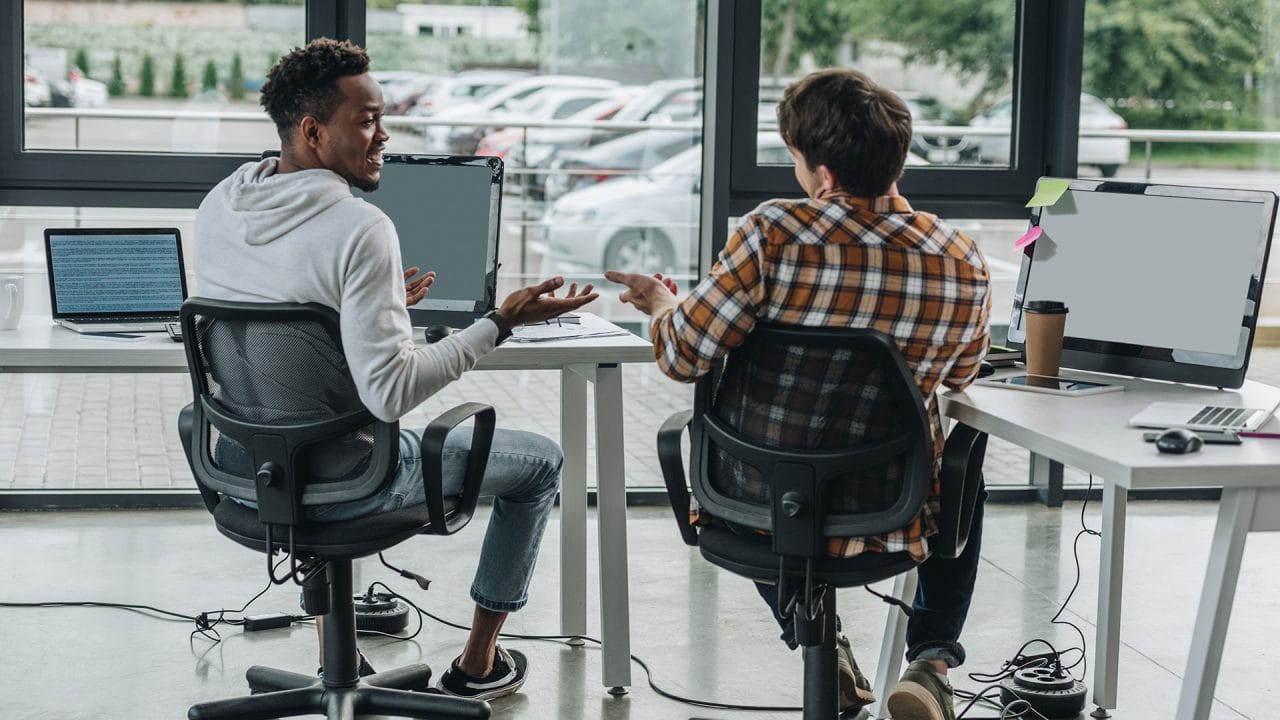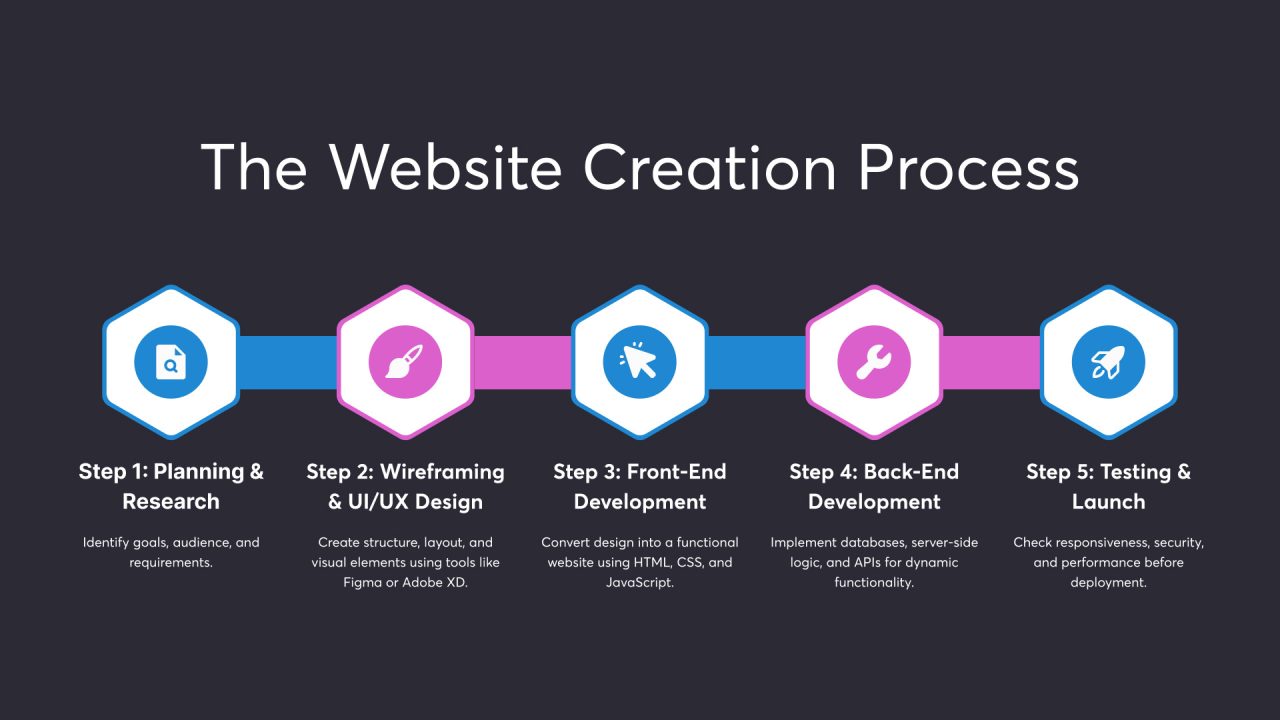
Website design and web development are two essential aspects of creating a successful online presence, but they focus on different parts of the process.
TL;DR: Website design focuses on visuals and user experience. Website development handles the functionality and code that make those visuals work.
Website design is the creative process of planning and arranging the visual elements of a website, including colours, typography, images, and overall layout. The goal of website design is to create an attractive, user-friendly interface that engages the visitor and communicates the message or brand. Designers use tools like Adobe Photoshop, Sketch or Figma to create wireframes, mockups and visual designs that guide the development process.
On the other hand, website development is all about the technical side of building a website, bringing the design to life with functional code. Developers use programming languages like HTML, CSS, JavaScript and frameworks to create the structure, style and interactive features of a website. They also work on the back-end functionality, database management and server-side scripting to make sure the website runs smoothly and efficiently.

Table of Contents
Understanding Website Design
Focuses on Visual Aspects and User Experience
Website design is a crucial aspect of creating a successful online presence. It focuses on the visual aspects and user experience of a website, including the layout, branding, graphics, and overall aesthetic appeal. A well-designed website can significantly improve user engagement, increase conversions, and enhance the overall reputation of a business or organisation. Web designers use various design elements, such as typography, color schemes, and imagery, to create a visually appealing and user-friendly website.
Good design today must also account for accessibility—designers should follow WCAG guidelines to support users with vision, mobility, and cognitive impairments. Modern websites are built with mobile users in mind first. This ‘mobile-first’ approach means designs must be responsive across all devices from the start.
Includes Design Elements such as Layout, Branding, and Graphics
Website design includes various design elements that work together to create a cohesive and effective website. These elements include:
- Layout: The arrangement of content, images, and other visual elements on a website. A well-thought-out layout ensures that information is presented clearly and logically, making it easy for users to navigate the site.
- Branding: The visual representation of a business or organisation, including logos, color schemes, and typography. Effective branding helps in establishing a strong identity and makes the website instantly recognisable.
- Graphics: The use of images, icons, and other visual elements to enhance the user experience and communicate information. High-quality graphics can make a website more engaging and visually appealing.
- User Interface (UI): The design of the interface between the user and the website, including buttons, forms, and other interactive elements. A well-designed UI ensures that users can interact with the website effortlessly, leading to a better overall experience.
By incorporating these design elements, web designers can create a website that is both visually appealing and user-friendly. The goal is to create a seamless and enjoyable experience for the user, which can lead to higher engagement and better conversion rates.
Understanding Website Development
Focuses on Functionality and Coding
Website development is the process of building and maintaining the functionality of a website. It focuses on the coding and technical aspects of website creation, ensuring that the site operates smoothly and efficiently. Web developers play a crucial role in this process, using various programming languages, databases, and server configurations to bring a website to life.
Performance optimisation is a key part of development. Developers use techniques like lazy loading, code splitting, and CDN integration to improve site speed and reduce bounce rates. Development choices also affect SEO—clean code structure, fast page loads, and schema markup all contribute to better rankings.
Web developers use programming languages such as HTML, CSS, and JavaScript to build and maintain websites. These languages form the backbone of web development, allowing developers to create the structure, style, and interactive features of a site. Additionally, web developers often work with databases and server configurations to ensure that websites are secure, scalable, and efficient.
Website Design vs Website Development: The Goals
Web design aims to determine what your website needs to look like to convert the most customers. Web designers answer questions like, “How can we convey your brand image through the website?” and “Where should we place a customer call-to-action?”
They create the visuals of a beautiful custom website aimed to provide the best user interface and customer experience. If we use the analogy of a phone, they are the people that decide what material the front and back case should be, if the phone has curved or straight edges, and where the home button goes.
Quick Comparison: Web Design vs Web Development
Here’s a side-by-side comparison of how designers and developers approach their craft:
| Feature | Web Design | Web Development |
|---|---|---|
| Focus | Visual aesthetics, user experience | Coding, functionality, performance |
| Tools Used | Photoshop, Figma, Sketch | HTML, CSS, JavaScript, frameworks |
| Goal | Create an attractive, user-friendly interface | Ensure the website functions properly |
| Output | Wireframes, mockups, UI elements | Responsive, interactive, and secure websites |
| Key Skills | Graphic design, UI/UX, branding | Programming, database management, security |
| Example Deliverables | Website layouts, prototypes | Functional websites, databases, APIs |
A web developer works on the website’s back end or makes everything work, as web development focuses on the technical implementation and functionality. They are behind the complex coding which makes each feature of your beautiful website work. To use the phone analogy again, they would be behind the circuit boards, battery, and things you wouldn’t even know about that make your phone function.
There is a lot of cross-over between the fields, and their leading goal is the same: to build a world-class website. They go hand in hand and should be compatible. Ultimately, the person who designs what a website looks like and how it works should be on the same team. The same can be said for our phone analogy. Imagine if someone designed the phone and someone else built the inside circuitry without ever speaking. That’s a recipe for disaster!
Website Design vs Website Development: The Priorities
A web designer will focus and nearly obsess over creating a clean, unique, and easy to navigate website for both your visitors and you. Anyone who can use Photoshop and knows a little HTML can get up and claim they are a web designer. However, a true professional would create a masterpiece, while an amateur would barely get the job done.
You can judge the difference by what they emphasise. A professional web designer would highlight how to entice your customer to make a purchase and leave an impression on them. The web pages would be clean and beautiful.
Understanding the career path in web design and web development can help you identify the skills and experience needed to advance in each field.
In contrast, an amateur will clutter your web pages. They may have unique design elements, but it might be difficult for customers to find what they are looking for, and the colours might be too loud and the text in your face.
A professional web developer wants a fast-loading and efficient website for you. They want to make the website easy to maintain as well. Adding new features and web pages would be a breeze if coded well. Do you expect to see a ton of traffic? Will your website work just as well under pressure? That’s what a web developer would work on.
Anyone with a little Python or Java under their belt can claim to be a web developer. An expert can get twice the work done in half the time and half the coding. They have mastery over the technology they use and are quick to solve problems.
What’s the point of a beautifully designed website when it has terrible loading speed? What if a customer used a Contact Us form or requested a quote for a service, and you were never notified? So many things can go wrong if the web developer doesn’t focus on the right things.
Website Design vs Website Development: The Technology
Web Design utilises aesthetic tools like Photoshop, Sketch, and other interface design tools. Web designers think creatively and focus on making your website visually stunning and leading customers to a call to action.
They will create the visual building blocks that make up your websites. They can use various tools to make custom action buttons, infographics, and a customer-funnelling landing page.
They will obsess over the colour, spacing, lines, and forms to create the perfect aesthetic for your website. When they are done, you will have a website that efficiently conveys your brand image and converts customers.
Full stack development is a comprehensive role that involves managing both the front-end and back-end aspects of web development, ensuring seamless functionality and integration.
A web designer can get away without knowing how to use coding languages and platforms. However, if they have a basic knowledge of different techniques and technology, they can design website features better around them.
If they know how to code, they can create your website from both the front and back. While the focus is on what stuff looks like, understanding the principles behind making it work helps them design better.
Web designers are inherently graphic design experts. They comprehend UX or UI design and can craft compelling wireframes, mockups, and storyboards. At the same time, they are marketing experts and understand human psychology to some extent. Knowing where to place call-to-action buttons and how to design a landing page for the most customer conversion comes with the territory.
To accomplish all this, they use tools like:
- Figma – The industry standard for UI design and prototyping, with real-time collaboration
- Adobe Creative Cloud – Especially Photoshop, Illustrator, and XD for visuals and interface mockups
- Webflow – A visual development tool bridging the gap between design and production-ready code
- Framer – Used for rapid prototyping and interactive UI design
- Editor X – An advanced Wix platform aimed at professional designers
- Spline – For integrating 3D elements into web interfaces
- Canva Pro – For quick marketing visuals and branded assets, especially in small teams
- Sketch – Still used for macOS-based UI design, though less dominant than before
Web developers use the technical machinery that makes your aesthetic website work. They utilise different programming languages, libraries, and frameworks to encode a website. While all developers use programming languages, web developers utilise what we call “client-side” code.
They work across both the front-end and back-end, using technologies like:
- JavaScript and TypeScript, along with modern frameworks like React, Vue, Svelte, and Next.js for dynamic interfaces
- CSS tools such as Tailwind CSS, CSS Modules, and PostCSS to streamline and scale styling
- Git for version control, often used with GitHub, GitLab, or Bitbucket
- Node.js, Deno, or Bun for server-side JavaScript runtime environments
- APIs and integration tools such as GraphQL and REST
- Containerisation with Docker and orchestration via Kubernetes for scalable infrastructure
- CI/CD pipelines and deployment platforms like Vercel, Netlify, or Cloudflare Pages for streamlined site delivery
- Serverless functions using AWS Lambda, Google Cloud Functions, or Cloudflare Workers
What is the Difference Between a Web Designer and a Web Developer?

The Artistry of Web Designers
The best website designers are the creative minds behind the visual aspects of a website. They work on the layout, colour scheme, and graphics to ensure the site is aesthetically pleasing and user-friendly. Website designers use tools like Adobe Photoshop, Figame and Sketch to create a website’s visual design and layout, focusing on the user experience and ensuring that the site is easy to navigate.
The Technical Expertise of Web Developers
On the other hand, web developers are the technical experts who turn the designs created by web designers into functioning websites. They work with various programming languages, such as HTML, CSS, and JavaScript, to build the site’s structure, and focus on back-end development to ensure the site works smoothly on the server and database side. Website developers can further be categorised into front-end developers, who work on the user interface, and back-end developers, who ensure that the site works smoothly on the server and database side.
Collaboration Between Designers and Developers
A successful website is often the result of a collaborative effort between web designers and web developers. In some cases, a freelance web designer may collaborate with developers to bring a project to life, especially for complex projects that require specialised skills. They work hand in hand, with designers focusing on the look and feel of the site while developers focus on the functionality. It is a symbiotic relationship where one cannot function optimally without the other.
The Outcome of a Cohesive Effort
When web designers and developers work together seamlessly, the result is a beautiful and functional website. The designers ensure the site is visually appealing, while the developers ensure it functions without glitches, providing a smooth user experience.
What Skills Are Necessary for a Web Designer?
Many web designers need to have a keen eye for design and a deep understanding of the principles of visual arts. They often work with graphic design software to create aesthetically pleasing and user-friendly layouts. A good website designer should also grasp essential programming languages such as HTML and CSS to communicate effectively with web developers and better understand what can be achieved in the development phase.
Web designers also need to stay updated with the latest trends in design to create modern and engaging websites. They should also have a good understanding of SEO principles to design a site that is beautiful and ranks well on search engines.
What Skills Are Necessary for a Web Developer?
On the other hand, web developers need to have a strong background in programming for creating websites. They work with HTML, CSS, JavaScript, and potentially backend languages like PHP or Python to build a functioning website from a designer’s mockup. A website developer should be proficient in various development frameworks and libraries to streamline the development process and build robust websites.
Developers must also have problem-solving skills to identify and fix bugs and ensure the website runs smoothly. They should also be familiar with version control systems to manage code and collaborate effectively with other developers.
How Do Web Designers and Developers Collaborate on a Project?
Collaboration between web designers and developers is crucial for the success of a web project. Initially, designers create the visual layout and design of the website, which is then handed over to the developers to build the functional site. Constant communication is vital throughout this process to ensure that the final product aligns with the initial vision.
Real-World Insight
A client once came to us with a clean, elegant homepage designed by a freelancer. Visually, it looked great — big hero image, scroll animations, sleek typography. But once it was handed to the dev, the issues started.
The animations were built using a bloated JavaScript library that tanked performance on mobile. The layout didn’t adapt to smaller screens, and key calls-to-action were buried below the fold on tablets. The visual design hadn’t accounted for breakpoints, speed, or touch interaction.
Our developer sat down with the designer, and together they reworked the layout into modular components. We replaced the heavy library with lightweight CSS transitions, cut mobile load time by 2.7 seconds, and surfaced the CTAs earlier in the scroll.
Design still led the experience. But development shaped how it actually worked in the real world. That’s collaboration done properly.
Designers and developers often hold regular meetings to discuss the project’s progress and address any issues that may arise. Utilising tools for project management and collaboration (at Chillybin, we use ClickUp) can facilitate a smoother workflow and ensure everyone is on the same page.
How to Choose the Right Professional for Your Project
Understanding Your Project Needs
Before you start looking for a professional, it is essential to identify the goals of your project and how you want to create websites. Are you looking to build a visually appealing website focusing on user experience? A web designer would be your go-to professional. However, a web developer would better meet your needs if your project requires complex functionalities and backend development.
Still unsure who to hire first? Use our visual roadmap of the typical website project timeline, this shows how both roles plug in and when.

The Importance of Portfolio Review
When hiring a web designer or developer, reviewing their portfolio can give you a sense of their style and the quality of work they deliver. When reviewing a portfolio, look for examples of responsive web design to ensure the professional can create adaptable and accessible websites. It allows you to see their previous work and understand if their expertise aligns with what you envision for your project. A well-rounded portfolio showcasing various projects can strongly indicate a professional’s competence and experience.
Setting a Clear Budget
Setting a clear budget for your project is a crucial step in the hiring process. The cost of a website can vary greatly, as a simple one-page website can cost $1,500, while a complex solution can cost $10-20,000 and beyond. It is advisable to have a clear discussion about the budget and the scope of work to avoid any misunderstandings later.
Collaborative Approach for a Cohesive Outcome
A project often requires the collaborative efforts of a web designer, a developer, and the client to bring a cohesive and functional website to life. In addition to design and development, understanding search engine optimisation is crucial for building a website that ranks well on search engines. Understanding how these professionals can collaborate can help in achieving a successful outcome. It is beneficial to hire a team like Chillybn, where web designers and developers work hand in hand, complementing each other’s skills to build a website that meets your expectations.
To put everything in perspective, web designers decide the ingredients and flavour of a cake that web developers mix and bake. Then the web developers add the frosting and decorations too!
While the developer makes the gears turn, a website designer makes your website a true asset. Web designers make your website look great and function well. They know how to draw the customer’s attention and leave the right impression for your brand. Knowing the difference between website design and website development helps you hire the right team to build a website.
Get in contact with the team at Chillybin today and we can start designing the perfect website for your business.
Frequently Asked Questions (FAQ)
Can one person do both design and development?
Sometimes. There are generalists, and they can be fine for small projects. But deep expertise in both areas is rare. For complex builds, or anything business-critical, it’s smarter to hire people who excel at their part of the work.
Do I always need both roles?
If you want a professional site that looks great and performs well—yes. You can get away with one or the other for basic needs. But you’ll likely hit walls: either a great-looking site that’s broken under the hood, or a fast one that fails to convert.
Which should I hire first?
It depends on the scope. If it’s brand-heavy or visual, start with design. If there are technical constraints or legacy systems to account for, speak with a developer early. Ideally, hire both upfront and get them talking from day one.
What should I look for in a portfolio?
Designers: clarity, consistency, and variety. Does the work suit the brand?
Developers: performance, responsiveness, and functionality. Do things load fast? Are features actually working?
Can I just use a website builder instead?
Yes — for straightforward sites. But website builders often cap your growth. You trade flexibility and performance for convenience. For anything that needs custom integrations, deeper SEO control, or proper scaling — you’ll outgrow a builder quickly.




